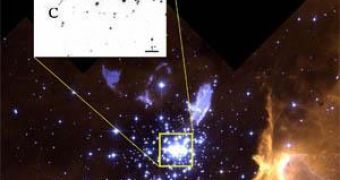Researchers from the University of Montreal, Canada, discovered that the giant star is also accompanied by another huge "sister," weighing 89 times more than our sun.
The way stars are formed is known only in theory, based on previous observations and on the limits of science, which proposes models stating that stars can reach masses up to 150 times that of the Sun. This had no practical basis, though, as until now, the most impressive star ever found had a mass only 83 times that of the Sun. Recently, three graduates (Olivier Schnurr, André-Nicolas Chené and Jules Casoli) and two teachers (Nicole St-Louis and Anthony F. J. Moffat), all from CRAQ (Centre de recherche en astrophysique du Québec), a center belonging to the University of Montreal in Canada, have broken that record twice.
The two stars that they found are closer to the masses stipulated in the astronomical models of star formation, while the one that weighs 116 Suns has broken the symbolic number of 100, which seemed to be elusive so far. The calculations were based on data received from the SINFONI integral field spectrograph equipped on the Very Large Telescope at the European Organization for Astronomical Research in the Southern Hemisphere (ESO) in Chile, as well as on infrared images sent by the Hubble telescope. The star system, called A1, is located in the giant star cluster known as NGC 3603 (to read "number of entry 3603 in the New General Catalog") and has a period of rotation of 3.77 days.
NCG 3603 is an immense HII area of the Constellation Carina, located in the Carina arm of the Milky Way, approximately 20.000 light years away from the Sun, and it was first uncovered in 1834, by John Frederick William Herschel. In its center lies an open cluster that holds about 2.000 massive, bright stars. The two stars in the A1 system that we’ve mentioned at the beginning of this article are so big and bright that the light they emit presents features only shown by "Wolf-Rayet" ones (evolved, massive, hot stars with high mass losses due to strong stellar winds). Stellar winds are flows of neutral or charged gas (high-energy electrons and protons that escape the gravity of the star because of its corona's high temperature) ejected from a star's upper atmosphere. Also, a binary system that emits X-rays at powers never recorded before in our galaxy has been found near the NCG 3603.

 14 DAY TRIAL //
14 DAY TRIAL //